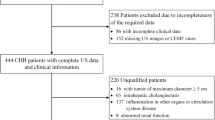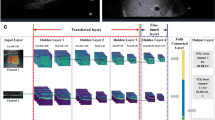Abstract
Background and aims
Chronic hepatitis B virus (CHB) infection remains a major global health burden and the non-invasive and accurate diagnosis of significant liver fibrosis (≥ F2) in CHB patients is clinically very important. This study aimed to assess the potential of the joint use of ultrasound images of liver parenchyma, liver stiffness values, and patients’ clinical parameters in a deep learning model to improve the diagnosis of ≥ F2 in CHB patients.
Methods
Of 527 CHB patients who underwent US examination, liver elastography and biopsy, 284 eligible patients were included. We developed a deep learning-based data integration network (DI-Net) to fuse the information of ultrasound images of liver parenchyma, liver stiffness values and patients’ clinical parameters for diagnosing ≥ F2 in CHB patients. The performance of DI-Net was cross-validated in a main cohort (n = 155) of the included patients and externally validated in an independent cohort (n = 129), with comparisons against single-source data-based models and other non-invasive methods in terms of the area under the receiver-operating-characteristic curve (AUC).
Results
DI-Net achieved an AUC of 0.943 (95% confidence interval [CI] 0.893–0.973) in the cross-validation, and an AUC of 0.901 (95% CI 0.834–0.945) in the external validation, which were significantly greater than those of the comparative methods (AUC ranges: 0.774–0.877 and 0.741–0.848 for cross- and external validations, respectively, ps < 0.01).
Conclusion
The joint use of ultrasound images of liver parenchyma, liver stiffness values, and patients’ clinical parameters in a deep learning model could significantly improve the diagnosis of ≥ F2 in CHB patients.
Graphical abstract




Similar content being viewed by others
Data availability
Data are available upon reasonable request to the corresponding authors.
References
Vittal A, Ghany MG. WHO guidelines for prevention, care and treatment of individuals infected with HBV a US perspective. Clin Liver Dis. 2019;23(3):417–432
Lampertico P, Agarwal K, Berg T, et al. EASL 2017 clinical practice guidelines on the management of hepatitis B virus infection. J Hepatol. 2017;67(2):370–398
Terrault NA, Lok ASF, McMahon BJ, et al. Update on prevention, diagnosis, and treatment of chronic hepatitis B: AASLD 2018 hepatitis B guidance. Hepatology. 2018;67(4):1560–1599
Bedossa P, Poynard T. An algorithm for the grading of activity in chronic hepatitis C. The METAVIR cooperative study group. Hepatology. 1996;24(2):289–293
Tan M, Bhadoria AS, Cui F, et al. Estimating the proportion of people with chronic hepatitis B virus infection eligible for hepatitis B antiviral treatment worldwide: a systematic review and meta-analysis. Lancet Gastroenterol. 2021;6(2):106–119
Zheng R-Q, Wang Q-H, Lu M-D, et al. Liver fibrosis in chronic viral hepatitis: an ultrasonographic study. World J Gastroenterol. 2003;9(11):2484
Colli A, Fraquelli M, Andreoletti M, et al. Severe liver fibrosis or cirrhosis: accuracy of US for detection—analysis of 300 cases. Radiology. 2003;227(1):89–94
Salvatore V, Borghi A, Peri E, et al. Relationship between hepatic haemodynamics assessed by Doppler ultrasound and liver stiffness. Dig Liver Dis. 2012;44(2):154–159
Wai CT, Greenson JK, Fontana RJ, et al. A simple noninvasive index can predict both significant fibrosis and cirrhosis in patients with chronic hepatitis C. Hepatology. 2003;38(2):518–526
Sterling RK, Lissen E, Clumeck N, et al. Development of a simple noninvasive index to predict significant fibrosis in patients with HIV/HCV coinfection. Hepatology. 2006;43(6):1317–1325
Siddiqui MS, Yamada G, Vuppalanchi R, et al. Diagnostic accuracy of noninvasive fibrosis models to detect change in fibrosis stage. Clin Gastroenterol Hepatol. 2019;17(9):1877–1885
Conti F, Serra C, Vukotic R, et al. Assessment of liver fibrosis with elastography point quantification vs other noninvasive methods. Clin Gastroenterol Hepatol. 2019;17(3):510–517
Kakegawa T, Sugimoto K, Kuroda H, et al. Diagnostic accuracy of two-dimensional shear wave elastography for liver fibrosis: a multicenter prospective study. Clin Gastroenterol Hepatol. 2021. https://doi.org/10.1016/j.cgh.2021.08.021
Wang K, Lu X, Zhou H, et al. Deep learning radiomics of shear wave elastography significantly improved diagnostic performance for assessing liver fibrosis in chronic hepatitis B: a prospective multicentre study. Gut. 2019;68(4):729–741
Lee JH, Joo I, Kang TW, et al. Deep learning with ultrasonography: automated classification of liver fibrosis using a deep convolutional neural network. Eur Radiol. 2020;30(2):1264–1273
Ruan D, Shi Y, Jin L, et al. An ultrasound image-based deep multi-scale texture network for liver fibrosis grading in patients with chronic HBV infection. Liver Int. 2021. https://doi.org/10.1111/liv.14999
Petitclerc L, Sebastiani G, Gilbert G, et al. Liver fibrosis: review of current imaging and MRI quantification techniques. J Magn Reson Imaging. 2017;45(5):1276–1295
Hui AY, Chan HL, Wong VW, et al. Identification of chronic hepatitis B patients without significant liver fibrosis by a simple noninvasive predictive model. Am J Gastroenterol. 2005;100(3):616–623
Zeng MD, Lu LG, Mao YM, et al. Prediction of significant fibrosis in HBeAg-positive patients with chronic hepatitis B by a noninvasive model. Hepatology. 2005;42(6):1437–1445
He K, Zhang X, Ren S, Sun J. Deep residual learning for image recognition. In: Proceedings of the IEEE conference on computer vision and pattern recognition 2016; pp. 770-778
Clopper CJ, Pearson ES. The use of confidence or fiducial limits illustrated in the case of the binomial. Biometrika. 1934;26(4):404–413
Delong ER, Delong DM, Clarkepearson DI. Comparing the areas under two or more correlated receiver operating characteristic curves: a nonparametric approach. Biometrics. 1988;44(3):837–845
Lee YA, Wallace MC, Friedman SL. Pathobiology of liver fibrosis: a translational success story. Gut. 2015;64(5):830–841
Xiao G, Yang J, Yan L. Comparison of diagnostic accuracy of aspartate aminotransferase to platelet ratio index and fibrosis-4 index for detecting liver fibrosis in adult patients with chronic hepatitis B virus infection: a systemic review and meta-analysis. Hepatology. 2015;61(1):292–302
Patel K, Sebastiani G. Limitations of non-invasive tests for assessment of liver fibrosis. JHEP Rep. 2020;2(2):100067
Martinez SM, Crespo G, Navasa M, et al. Noninvasive assessment of liver fibrosis. Hepatology. 2011;53(1):325–335
Ferraioli G, Wong VW-S, Castera L, et al. Liver ultrasound elastography: an update to the world federation for ultrasound in medicine and biology guidelines and recommendations. Ultrasound Med Biol. 2018;44(12):2419–2440
Simonyan K, Zisserman A. Very deep convolutional networks for large-scale image recognition. In: Int Conf Learn Represent; 2015; San Diego, CA, US.
Szegedy C, Vanhoucke V, Ioffe S, et al. Rethinking the inception architecture for computer vision. In: IEEE Conf Comput Vision Pattern Recognit; 2016; Las Vegas, NV, USA.
Huang G, Liu Z, Van der Maaten L, et al. Densely Connected Convolutional Networks. In: IEEE Conf Comput Vision Pattern Recognit; 2017; Honolulu, HI, USA.
Acknowledgements
The authors would like to thank all of the patients for their participation in this study.
Funding
This work was partially supported by National Natural Science Foundation of China under Grants 81871429 and 61901282, and Key-Area Research and Development Program of Guangdong Province under Grant 2020B1111130002.
Author information
Authors and Affiliations
Contributions
ZL and HW designed the study. ZL, CD and XC had full access to all the data. ZL, HW, ZZ and QL analyzed the data. ZL and HW wrote the manuscript. CD and XC fully supervised the study. All authors provided substantial comments on drafts and approved the final report.
Corresponding authors
Ethics declarations
Conflict of interest
Zhong Liu, Huiying Wen, Ziqi Zhu, Qinyuan Li, Li Liu, Tianjiao Li, Wencong Xu, Chao Hou, Bin Huang, Zhiyan Li, Changfeng Dong, and Xin Chen have no conflicts of interest to disclose.
Animal research
Not applicable.
Consent to participate
This study was approved by the hospital’s ethical review board (Shenzhen Third People’s Hospital, Shenzhen, China) and fully complied with the 1964 Helsinki declaration and its later amendments. Informed consent was obtained from all the patients enrolled.
Consent to publish
All authors approved the publication of the manuscript.
Plant reproducibility
Not applicable.
Clinical trial registration
Not applicable.
Additional information
Publisher's Note
Springer Nature remains neutral with regard to jurisdictional claims in published maps and institutional affiliations.
Supplementary Information
Below is the link to the electronic supplementary material.
Rights and permissions
About this article
Cite this article
Liu, Z., Wen, H., Zhu, Z. et al. Diagnosis of significant liver fibrosis in patients with chronic hepatitis B using a deep learning-based data integration network. Hepatol Int 16, 526–536 (2022). https://doi.org/10.1007/s12072-021-10294-4
Received:
Accepted:
Published:
Issue Date:
DOI: https://doi.org/10.1007/s12072-021-10294-4




